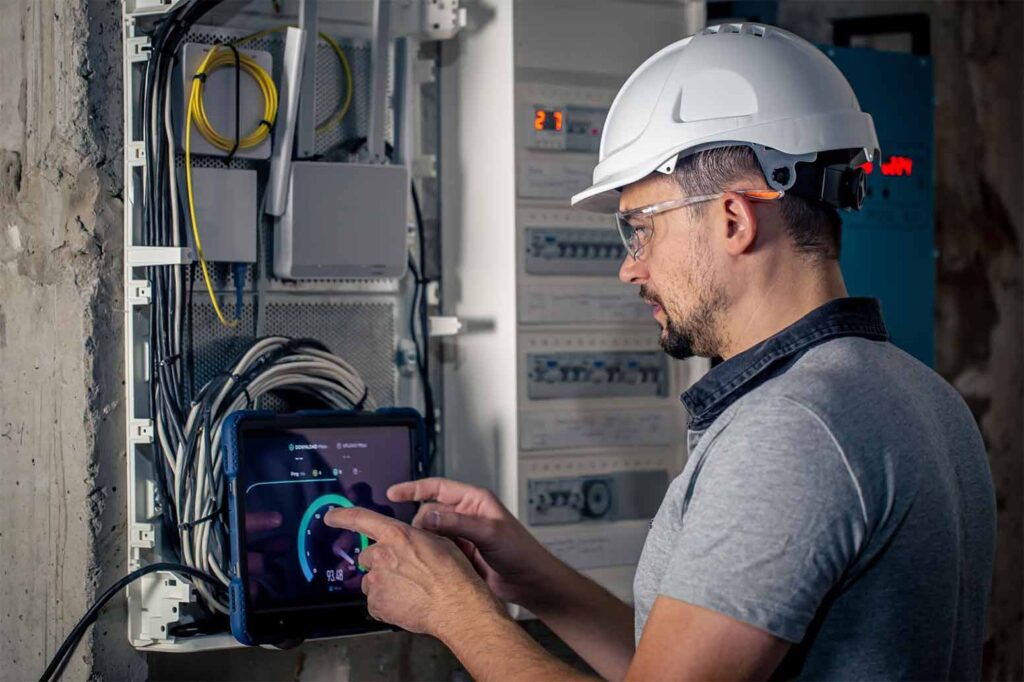How To Price Residential Electrical Work? Step-by-Step Guide

This comprehensive guide pulls back the curtain on how to price residential electrical work, covering everything you need to know:
Accurately estimating an electrical job isn’t just about adding up wires and outlets; it’s a high-wire act of financial finesse!
You’ve got to juggle covering your costs, making a decent profit (because let’s be honest, you’re not doing this for free!), and still offering a competitive price that doesn’t send clients running for the hills. It’s a delicate dance, but mastering it is key to keeping the lights on in your own business.
From pricing residential work and understanding typical electrician rates to calculating hourly costs, project expenses, permit and safety considerations, and ultimately, mastering the art of calculating the total cost of electrical services.
So, grab your calculator (and maybe keep your favorite invoice maker handy in case inspiration strikes!), and let’s get wired into the world of accurate estimating!
Steps to Price Residential Electrical Work
Average electrical job estimates
For small electrical businesses, accurate pricing is the key to staying afloat and thriving. Electricians generally structure their fees in a few standard ways.
Hourly rates typically range from $50 to $100, but that initial service call—which covers travel and setup—often comes with a premium, clocking in around $150.
Now, if it’s an emergency—think sparking wires or a total blackout—expect those rates to surge, doubling to between $100 and $200 per hour.
Beyond hourly work, many electricians also price by the project itself, with common electrical jobs typically falling in the $162 to $535 range.
Proactive approach for electrical job estimate
Landing profitable electrical jobs starts long before you turn a single screw. It begins with a proactive and meticulous approach to estimating.
Think of your electrical job estimate as the blueprint for a successful project: a clear, comprehensive, and accurate forecast of both the work involved and its associated costs.
A well-crafted electrical job estimate does more than just state a price; it builds trust with clients by clearly outlining the scope of work and instilling confidence in your expertise.
Simultaneously, it protects your business by anticipating potential challenges and preventing costly surprises that can eat into your profits.
Analyze past projects
Don’t just file away those completed job records—they’re a goldmine of information! Take a good, hard look at your past projects and compare your initial electrical job estimates with the actual time and resources you ended up using.
This internal review can reveal some valuable trends. You might find you’re consistently underpricing certain types of work or that some tasks always take longer than you first thought.
These insights are crucial for fine-tuning your pricing strategy and boosting both accuracy and profitability on future jobs. It’s like a post-game analysis for your business—learn from the past to win in the future.
Gather customer feedback
Once a project wraps up, don’t just send the invoice and call it a day. Take the time to chat with your clients about their experience. Ask them directly about the value they feel they received for the price they paid.
This firsthand feedback is pure gold—it gives you invaluable insight into customer perception and doesn’t cost you a dime. This direct line of communication can significantly inform your pricing strategy and, ultimately, lead to happier clients and more successful projects.
Connect with industry professionals
Don’t operate in a silo! Building relationships with other electrical contractors, especially those working in different regions, can be incredibly beneficial. Sharing experiences and insights with fellow pros offers fresh perspectives on pricing strategies you might not have considered.
You can gain valuable intel on how others in the industry are estimating electrical jobs in different markets, giving you a broader understanding of the landscape.
This networking can happen through various avenues like online forums, local business networking events, or industry associations. It’s about learning from each other and strengthening the entire electrical community.

The building blocks of an electrical job estimate
Think of estimating an electrical job like constructing a building: you can’t start putting up walls without a strong foundation. This section breaks down those essential components, providing a clear roadmap for accurate and profitable pricing. Let’s get building!
Labor costs (hourly rates)
Labor costs are typically the biggest chunk of any electrical job’s budget, so knowing your hourly rate (or your employees’) is absolutely essential.
Remember, average electrician prices and hourly rates aren’t set in stone; they bounce around depending on factors like where you’re located, your experience level, your specialization (whether you focus on homes, businesses, or industrial sites), and even the current demand in your local market.
Doing your homework and researching the going rates in your area is crucial for setting a price that’s both competitive and profitable. Keep in mind, that your hourly rate estimate shouldn’t just cover the time you’re actually on the electrical job; it needs to factor in a few other key things, too:
- Travel time: Getting to and from the job site isn’t free—it takes time and fuel, both of which need to be accounted for.
- Preparation and cleanup: Setting up your workspace and cleaning up afterward might not seem like a huge chunk of time, but it adds up and should be included in your calculations.
- Administrative tasks: Paperwork, phone calls, emails, scheduling—all those essential but non-billable tasks take time and need to be factored into your overhead.
- Training and professional development: Staying up-to-date with the latest codes, technologies, and best practices is crucial, and the time and cost of training should be considered.
- Benefits and insurance: If you have employees, the costs of benefits like health insurance and workers’ compensation need to be factored into your hourly rate to ensure you’re covering those expenses.
Material costs
Getting your material takeoffs spot-on is absolutely crucial for accurate estimating. This means creating a super-detailed list of every single item you’ll need for the electrical job, specifying both the quantity and type of each.
Since material prices can change, getting up-to-date quotes from reliable suppliers is a must. It’s also a smart move to add a small buffer—a percentage for potential waste, breakage, or those unexpected “oops” moments.
This “materials” category covers everything physical used in the project, from the most basic to the super-specialized stuff:
- Electrical Wiring: Different gauges and types of wiring (e.g., Romex, THHN).
- Conduit: Metal or plastic tubing used to protect wiring.
- Outlets and switches: Receptacles, switches, and dimmer controls.
- Circuit breakers and panels: Components that protect electrical systems and circuits from overloads.
- Light fixtures and bulbs: Indoor and outdoor lighting fixtures and various types of bulbs.
- Junction boxes and connectors: Boxes used to connect and protect wiring connections.
- Mounting hardware and fasteners (installation costs): Screws, bolts, and other hardware used for installation.
- Other electrical components: such as ceiling fans or electrical panels.
Permits and inspections
Electrical work often requires permits and inspections to ensure everything is up to code and meets safety standards. These aren’t just bureaucratic hoops to jump through; they’re vital for ensuring the safety and legality of the work you do.
Therefore, researching the necessary permits and their associated fees in your specific area is a must-do. Be sure to explicitly include these costs in your electrical job estimates.
Doing so not only shows professionalism and transparency to your clients but also prevents any unpleasant financial surprises down the road.
Overhead costs
Overhead costs are the ongoing expenses of running your electrical business that aren’t tied to any single job. They’re the essential expenses that keep the lights on (literally and figuratively) and are crucial for your long-term financial health.
To stay profitable, a portion of these overhead costs needs to be factored into each job you quote. Here are some common examples:
- Insurance: This includes liability insurance (to protect you from potential lawsuits), workers’ compensation (if you have employees), and any other business-related insurance premiums.
- Vehicle expenses: If you use company vehicles, you need to account for fuel, regular maintenance, repairs, and vehicle insurance.
- Office rent or mortgage: Whether you rent office space or own your building, these costs need to be factored into your overhead.
- Marketing and advertising: Getting the word out about your business costs money, whether it’s through online ads, print materials, or other promotional efforts.
- Accounting and legal fees: Unless you’re a whiz at bookkeeping and legal matters, you’ll likely need to pay for professional accounting and legal services.
- Utilities: If you have a business premises, you’ll have utility bills for things like electricity, water, and internet service.
- Any other additional costs.
Profit margin
Profit margin is what’s left over after you’ve paid for everything: labor, materials, permits, overhead—the whole shebang. It’s the financial reward for your hard work and the lifeblood of your business.
A healthy profit margin isn’t just about putting money in your pocket; it’s also crucial for reinvesting in your business, allowing you to grow, upgrade equipment, hire more staff, and ensure long-term stability. It’s the fuel that keeps your business engine running.

Pricing residential electrical work
Key factors
Several key factors influence how residential electrical work is priced.
The complexity of the job is a major driver; intricate wiring, custom lighting designs, or tackling outdated systems in older homes all require more time, specialized skills, and potentially unique materials, which naturally leads to a higher price tag.
How easy it is to access the work area also plays a significant role. Squeezing into tight attics, navigating cramped crawl spaces, or working in other difficult-to-reach areas increases labor time and difficulty, impacting the overall cost.
Emergency services, due to their urgent nature and the inconvenience they cause, typically command higher rates for after-hours, weekend, or holiday calls.
Finally, the distance you have to travel to the job site can also factor into the price, as longer trips add to labor costs and may warrant a separate travel fee.
Average professional electrician prices and job costs
It’s important to remember that average electrician prices and job costs aren’t uniform across the country. There can be significant regional differences due to factors like the local cost of living, the level of competition among electricians in the area, and the overall demand for electrical services.
To get a realistic picture of pricing in your specific market, do some local research. Online directories, contacting local electricians for quotes (even if you’re not hiring them for a job), and consulting industry publications can all provide valuable insights into the going rates in your area.
Permits and safety
Never cut corners on permits and safety. Getting the required permits isn’t just about ticking a legal box; it shows your clients that you’re a professional who takes their safety (and the legality of the job) seriously.
Sticking to all relevant safety regulations, using the right personal protective equipment (PPE), and following industry best practices are essential for preventing accidents, injuries, and potential legal trouble. Safety isn’t an optional extra—it’s the foundation of any reputable electrical business.
How to price residential electrical work: a detailed example
Alright, let’s put all this theory into practice and walk through a real-world example: calculating the cost of installing new wiring for a home office. This will give you a concrete idea of how all the different elements come together to form a complete estimate for an electrical job.
1. Define the scope
The project involves installing new wiring for four outlets, two light fixtures, and a dedicated circuit for a computer.
2. Material takeoff
- Wiring (14/2 Romex): 50 feet @ $0.50/foot = $25
- Outlets (4): $3 each = $12
- Light fixtures (2): $50 each = $100
- Junction boxes (6): $2 each = $12
- Circuit breaker (1): $10
- Other hardware: $5
Total material cost: $164
3. Estimate labor hours
Based on experience, you estimate the job will take 6 hours.
4. Determine hourly rate
Your hourly rate is $80.
5. Calculate labor cost
6 hours x $80/hour = $480

6. Account for permit fees
The local permit fee for this type of work is $50.
7. Allocate overhead
You estimate your overhead at 15% of the combined material and labor costs: 15% of ($164 + $480) = $97
8. Calculate total job cost (before profit)
$164 (materials) + $480 (labor) + $50 (permit) + $97 (overhead) = $791
9. Determine profit margin
You aim for a 20% profit margin: 20% of $791 = $158.20
10. Final estimate
$791 + $158.20 = $949.20
Alternatively, you can use our estimate generator to make the process faster and much easier!
The wrap-up
So there you have it! Estimating an electrical job accurately is a key skill for any electrician, whether you’re a seasoned pro or just getting your feet wet.
It’s not just about crunching numbers; it’s about understanding how all the pieces fit together—labor, materials, overhead, and profit—while keeping safety and regulations top of mind.
By mastering the tips and techniques we’ve covered you’ll be able to confidently price your services, build trust with your clients, and set your electrical business up for success.

Sarah Shaar is a SEO Content Writer born in Lebanon, and studied at the Lebanese American University.
With a background in journalism and a Master's in Digital Marketing, Sarah thrives in adapting to various copywriting disciplines.
Her passion lies in crafting creative and compelling content that speaks directly to her audiences.
